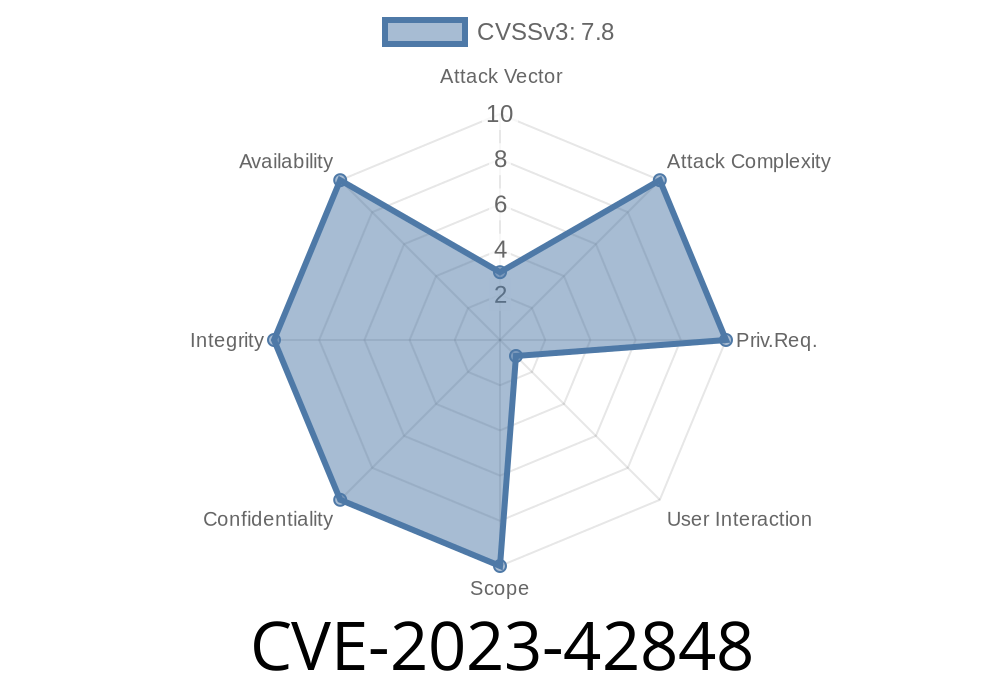On October 25, 2023, Apple released security updates patching a critical vulnerability tracked as CVE-2023-42848. If you’re using an iPhone, iPad, Mac, Apple TV, or Apple Watch, you need to pay attention—this bug could let attackers exploit your device just by getting you to open a specially crafted image.
Let’s break down what happened, how it could be abused, and why it matters—plus we’ll look at a simple hypothetical exploit to really make it clear.
What is CVE-2023-42848?
Apple describes CVE-2023-42848 as:
> “Processing a maliciously crafted image may lead to heap corruption.”
That means if your device processes an image file made by an attacker (like a weird PNG or JPEG), it can corrupt the memory of the app (like Photos, Messages, or Safari), which could allow the attacker to run code of their choice—potentially taking control of your device.
tvOS 17.1
Primary Source:
- Apple Security Update Page
- NIST NVD Entry
Technical Details, Simplified
Apple said the issue was addressed with “improved bounds checks”. With bugs like this, the underlying problem is usually a piece of code that assumes things about a file (like an image’s size or pixel data) without actually verifying if those assumptions are safe.
For example, let’s say this code processes image data
// Vulnerable code snippet (for educational purposes)
void processImage(unsigned char *input, int length) {
unsigned char buffer[1024];
// BAD: Does not check if input is bigger than buffer
memcpy(buffer, input, length);
// ...process buffer...
}
If length is bigger than 1024, memcpy will write data outside buffer—corrupting the heap memory and opening the door for attackers to hijack the program’s execution.
Exploit Scenario: How Could an Attacker Use This?
1. Attacker crafts a malicious image that’s specially built to exploit the faulty image-processing code.
2. Victim receives the image via message, email, web, or any app that uses Apple’s image libraries.
Device processes the image (even just previewing it), causing heap corruption.
4. If the exploit is perfect, the attacker gains code execution—possibly taking control over the device, stealing data, or installing malware.
This kind of attack can often be weaponized for “zero-click” exploits—no user interaction needed!
Why Is Heap Corruption So Dangerous?
Heap corruption means overwriting chunks of memory that the application uses. Skilled attackers can use this chaos to redirect what program instructions get executed. In other words: if the bug is reliable enough, they can run malicious code—like spyware—on your device.
How Was It Fixed?
Apple didn’t give deep details (as is usual for them), but “improved bounds checks” means the vulnerable code now properly checks that it never writes more data than it should:
// Fixed code snippet
void processImage(unsigned char *input, int length) {
unsigned char buffer[1024];
// GOOD: Enforce safe bounds for memcpy
int copyLen = length < 1024 ? length : 1024;
memcpy(buffer, input, copyLen);
// ...process buffer...
}
This prevents the out-of-bounds write that leads to heap corruption.
Proof-of-Concept Outline (Educational Only)
While a real exploit would be highly technical and specific to Apple’s closed-source image libraries (likely ImageIO), here’s a hypothetical pseudocode for crafting a malicious image:
# WARNING: For education only. Don't use this for evil!
malicious_image = bytearray()
malicious_image += b'\x89PNG\r\n\x1a\n' # PNG header
malicious_image += b'A' * 200 # Overlong data that overflows buffer
with open('evil.png', 'wb') as f:
f.write(malicious_image)
If a vulnerable device processes this file, it _might_ trigger the bug in older, unpatched devices.
Update all your devices! Get the latest iOS, macOS, watchOS, and tvOS versions.
- Be careful about opening image files from unknown sources—but don’t rely on this. These vulnerabilities are often exploited with zero interaction.
References
- Apple HT213763—Security Updates
- Apple CVE-2023-42848
- NIST NVD: CVE-2023-42848
Summary
CVE-2023-42848 is a serious memory corruption bug in Apple’s image-processing libraries. Patch your devices now, because just getting a malicious image could put your privacy and security at risk.
Stay safe, keep your software fresh, and keep an eye on security news—threats like this show why updates matter!
Timeline
Published on: 02/21/2024 07:15:49 UTC
Last modified on: 08/26/2024 15:35:00 UTC
